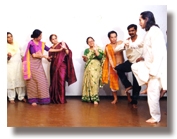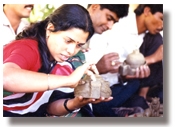 CULTURAL RENDEZVOUS: The dancers who participated in ‘Shifting Grounds.' On the extreme right are my Gurus Anusha and Narendra Kumar
CULTURAL RENDEZVOUS: The dancers who participated in ‘Shifting Grounds.' On the extreme right are my Gurus Anusha and Narendra KumarAn article by SAVITHA GAUTAM in THE HINDU that features my Gurus
Artists from three continents came together for ‘Shifting Grounds’, a music-dance creation, performed in Germany.

Lalgudi G.J.R. Krishnan is bubbling with excitement these days. The reason? His recent success in Germany where he participated in ‘Shifting Grounds,’ a music-dance production put together by the University of Cologne under the leadership of producer Prof. Dr. Hans Neuhoff of the Cologne University.
The shows, held during May in three German cities (Cologne, Düsseldorf and Aachen), were supported by DAAD (German Academic Exchange Service).
“This is the first time, musicians and dancers from three continents — Asia, Africa and Europe — have pooled their talent to create a production that talks of life, human emotions and the art of communication,” says Krishnan, sitting in his T. Nagar home.
‘Shifting Grounds’ is the culmination of one and a half years of intense discussions and two months of rigorous rehearsals. Eight 90-minute shows were presented with 20 artists from Europe, West Africa (Senegal and Burkina Faso) and India (most of them were in Germany under the DAAD Fellowship programme) showcasing their talent.
The team
The production was conceptualised and produced by Hans, while music was composed by fellow professor and pianist Paulo Alvares and choreographed by Vera Sanders, also from the Cologne University.
The Indian flavour was provided by Krishnan and his violin, Ghatam V. Suresh, and dancers Anusha, Narendra Kumar and Sangeeta Isvaran.
On the genesis of the project, Hans in a telephonic conversation, explains, “The theme has its roots in the RASA theory of the Indian arts. It deals with the basic emotions of Man which can be expressed in many ways and yet, is universal. ‘Shifting Grounds’ is also about trans-cultural communication where non-verbal art forms are effectively employed to convey human emotions.”
Paulo shares similar thoughts. “The key words in this production are ‘contrasting’ and ‘shifting.’ ‘Contrasting’ because in the beginning, everything is so different — the styles, the traditions and even the language of expression. But finally, there is only one thought, one emotion. ‘Shifting’ because the styles literally move from one to the next in a smooth, harmonious manner.”
The stage for ‘Shifting Grounds’ was shared by two pianos, a violin and various percussion instruments.
The music was an eclectic mix of Western classical notes, Carnatic ragas and African rhythms. Says Paulo, “Believe me, we did not have a score at all! The music was in my mind. I allowed each musician the freedom to explore within a framework. That’s how the music evolved.” Paul, not familiar with Indian music till then, discovered “new sounds, rich cultures and different ways of thinking musically.”
The ragas represented
Talking about his musical contribution, Krishnan says, “I played snatches of such grand ragas as Varali, Vachaspati (‘Hans specifically requested it’), Revagupti and Kalyanavasantham. The Vachaspati raga alapana was the longest at 10 minutes! The raga suited the mood of the dance movements which express peace and calm.”
Hans, who studied under Lalgudi Jayaraman years ago, says, “Krishnan’s piece was the only sustained melodic sound in the whole production. his playing has won him many fans.”
For both Krishnan and Suresh, the German sojourn was a fun-filled learning experience.
Recalls Krishnan, “On the first day of the rehearsal, I did not know anybody except fellow Indians. Also, most of the others did not know English. But once I picked up my violin and played, the differences simply faded. Clichéd it may be, but music truly transcends barriers.”
Suresh adds, “There were some instruments which I had never seen before. Similarly, the African drummers were curious about the ghatam and the thavil. During the two months we were there, we were like one big family.
“In fact, Krishnan and I had to share an apartment with Fatou Cisse, a singer from Senegal. We had a fabulous time, trying out new recipes and learning French words. And yes, we taught her Tamil words.”
Talking about her role, Vera Sander says, “I spent two weeks in India trying to understand the various classical dance forms. I learnt about the mathematical precision, rhythm patterns and phrasing of Indian dances as also the strong link between dance and music.”
Her challenge was to create something which linked diverse styles without losing the distinct identity of each. “It was quite a challenge because we had to move away from the individual and find a common ground. In the end, what mattered was how effectively the movements conveyed the emotions…”
Will ‘Shifting Grounds’ find an Indian audience? Hans rues, “It is an expensive proposition. I do hope to take it to other parts of the globe.” But how? That remains to be seen.
(This article appeared in the Friday Review of The Hindu dated June 19, 2009)

